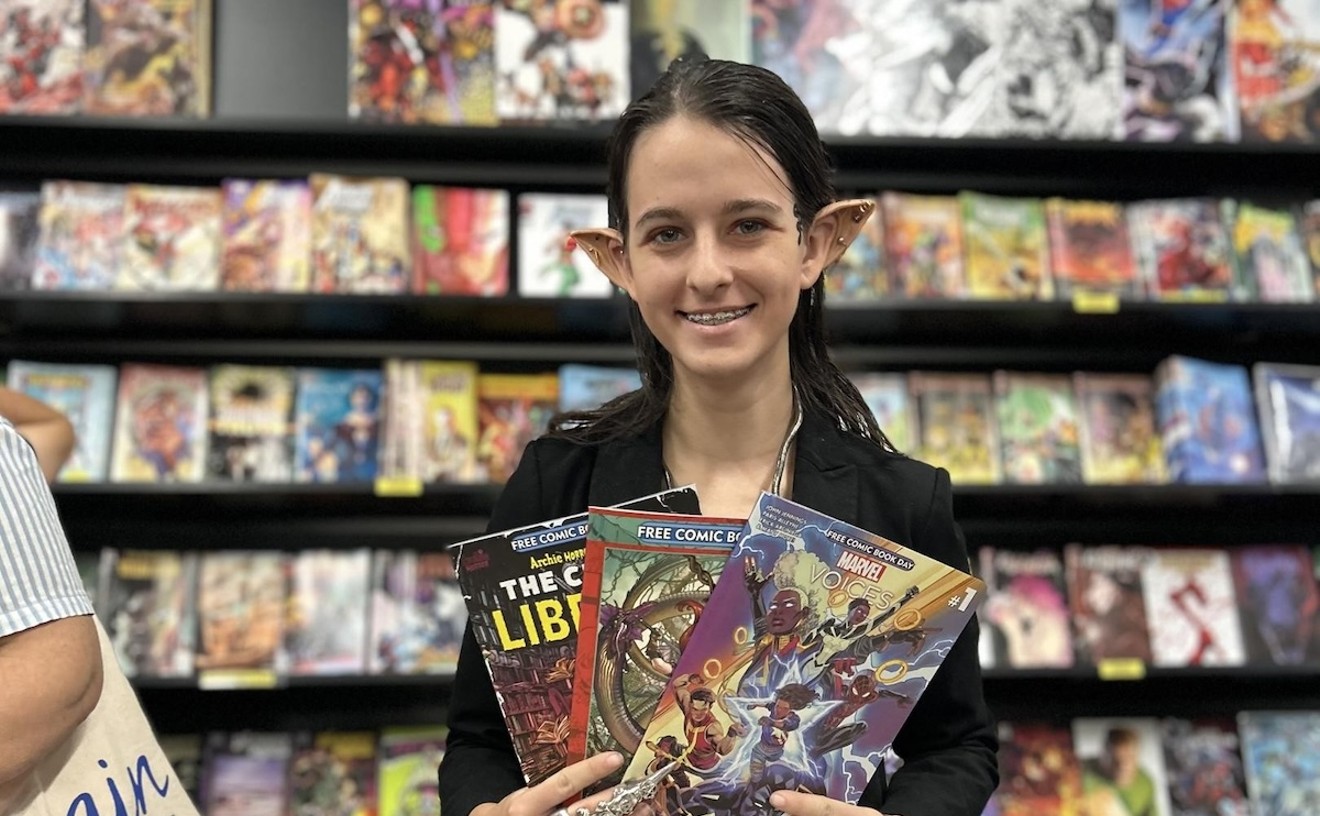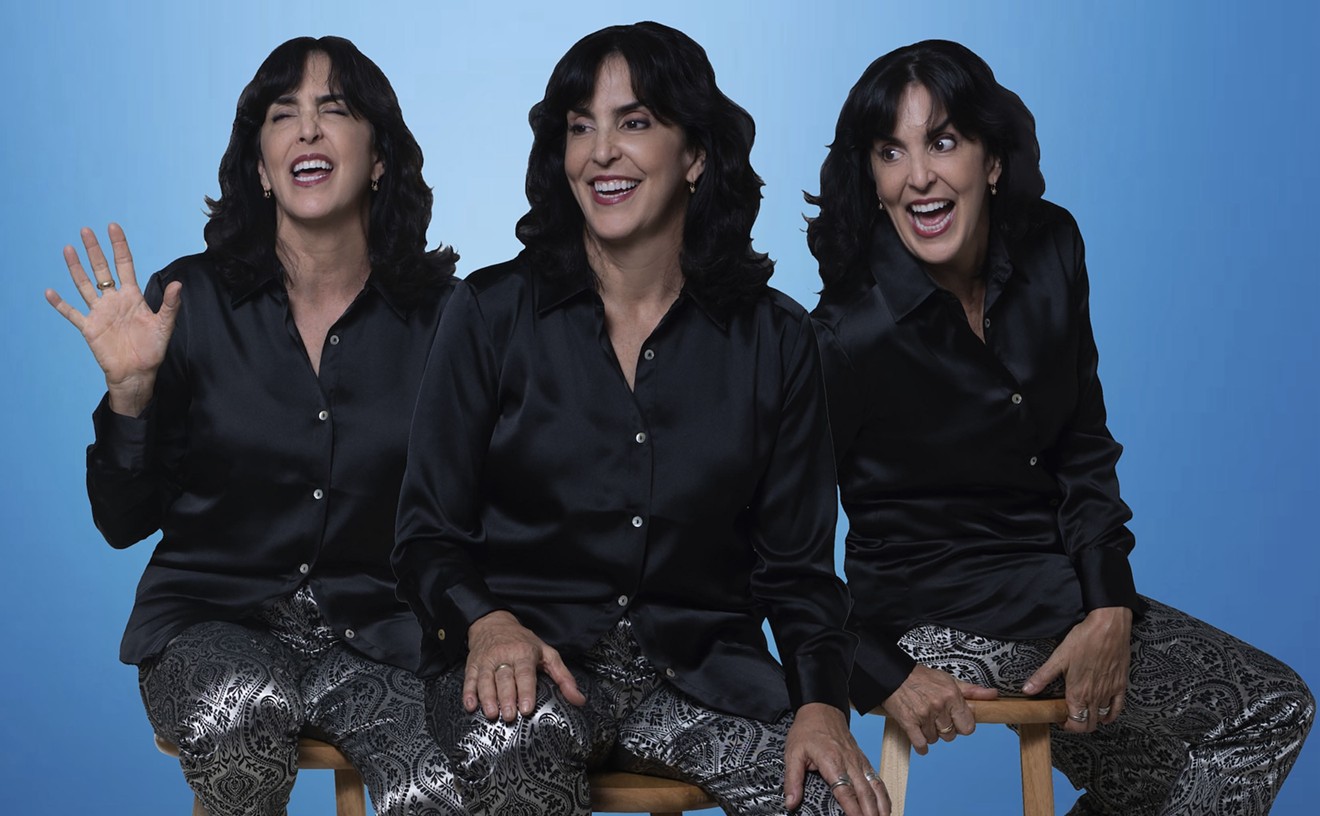With ruthless efficiency, Lee Materazzi calls to mind a gangland slaying in a Jersey gravel pit.
Her c-print Head in Rocks knifes the gut, evoking what could easily have been a scene lifted from The Sopranos, in which the Bada Bing brethren send a nasty message to anyone contemplating singing like a canary to the feds.
In it, the image of a young man, wearing a light blue shirt, jeans, and sneakers, appears like a pigeon plucked off a power line, his skull buried in a field of golf-ball-size stones. The disarming picture hints at unspoken violence, while the unfortunate mook's legs are splayed akimbo, suggesting the desperate rattle of a dying gasp.
Head in Rocks is one of the many arresting images in "In Between Spaces," Materazzi's first solo show at Spinello Gallery. The exhibit features two dueling bodies of work.
One depicts models whose heads are obliterated by bundles of rags. The other portrays people whose pates are buried in walls, furniture, floors, or dirt. They are equally striking, explaining why Materazzi is a young talent on the verge of making her bones with the Big Orange's monied art mob.
Her deftly staged and cunningly executed photographs have been generating plenty of buzz, and her show has been extended with an encore reception organized for this Saturday's Wynwood gallery crawl.
"This has been our most successful show ever," gushes gallery owner Anthony Spinello, who calls Materazzi one of "Miami's rising stars."
Since the exhibit opened in early May, the dealer has sold more than 40 of the artist's limited-edition photographs, most in the $600 to $900 range.
Denis Scholl and Marty Margulies are among the bigwig collectors betting big and early on Materazzi, Spinello adds.
"Many young artists would give their eye teeth to enter these collections," the dealer asserts. "I started working with Lee in 2005. Since then, her work has dramatically evolved. She just radiates this quiet confidence and is very intuitive with her subjects. I'm excited that these collectors are experiencing what I experience and beginning to see what I see."
During a recent visit to the gallery, the 25-year-old Materazzi, who was born in Virginia and moved here with her family when she was nine, spoke of her journey from budding fashion designer to conceptual artist.
She studied garment design at London's Central Saint Martins College of Art and Design, the institute that also produced pop singer Sade, visual artists Lucian Freud and Gilbert & George, fashion designer John Galliano, and actors Colin Firth and John Hurt.
"I decided the garment industry wasn't for me and switched to sculpture," Materazzi recalls. "But a lot of the sculptural objects I was making at the time were related to people, I realized."
When she ventured into photography a few years ago, sculptural elements seeped into her work. At Spinello, traces of her foray into fashion crop up as well.
Her Clothes on Head series depicts nude men and women with their domes swathed in elaborate turbans crafted from the subjects' own clothes.
She typically photographs local artists and friends whose faces are totally obscured. She poses them in various positions in the confines of their own homes.
One man is perched on a toilet, while another leans against a chest of drawers in his bedroom.
Materazzi undermines the glamour myth perpetuated by glossy fashion magazines, questioning concepts of identity and sexuality as well as exploitive media representation. The gaze of her models is absent, and any sense of eroticism is neutralized.
"I try to make them feel comfortable when posing, and the works are more like portraits that reflect the subjects' personality," the artist explains. "That's why I ask them to choose articles of their own clothes for the headdresses."
In Clothes on Head (Yellow Kitchen), a woman with shaved genitalia faces the viewer. Sandwiched between kitchen appliances, she stands with one hand cocked on a hip. The laundry pile balanced on her graceful neck contains a blue bra and belt and wildly patterned garments that starkly contrast with the mustard-hued kitchen wall. On the floor, near her feet, rests a pair of ceramic dog bowls.
Equally compelling is the picture of a woman posing in front of a shower with tawny marble-veined walls that set off the subject's ivory skin. This girl desperately needs a bikini wax, for her bush seems as voluminous as the dense thatch of cloth she wears as a crown. Oddly, there is a haunting quality to the image of this woman, who appears passive as her arms dangle almost limply at her sides. She projects a palpable yet dignified shyness that tugs at the heart and the eyes.
In Materazzi's more recent Head In series, the subjects are all dressed, but they engender a more intense feeling of claustrophobia.
At a glance, these searing images look Photoshopped. No chance.
Materazzi stages elaborate theatrical scenes in which people seem to be fleeing their immediate surroundings or picking at the scab of estrangement by burying their heads in various surfaces. They appear vulnerable — victims of life's banal intrusions, against which they fold without a fight. They have an Alice-down-the-rabbit-hole sensibility that jukes spectators out of their shoes with a nifty head fake.
Head in Table captures a man wearing a tank top and boxer shorts bent over a dining table, as if losing his lunch, while his noggin disappears into a white tablecloth. The remains of a peanut butter and jelly sandwich sit on a plate, and he holds a glass of OJ in one hand. The image is seamless and suggests he might have landed on the wrong end of a squabble with the wife.
Other enigmatic images depict women sprouting organically from their lawns or doing handstands in their living rooms.
To accomplish these optical illusions, Materazzi usually employs a bucket under the scene's surface so the subject can safely entomb his or her head during the shoot.
"Some of these are natural found spaces; others are constructed," she says. "People have to trust me when I'm working on these pictures, because they feel confined with their heads stuck in a hole. But it's usually not for more than half an hour," the artist laughs.
Now that the lid is off her bucket, Materazzi has been left reeling from the attention she has begun to receive.
"It's been wonderful to have the support of these collectors, and I'm still trying to take it all in," she whispers bashfully.
If Materazzi continues at this pace, she will need to find an awfully big hole in which to hide.










